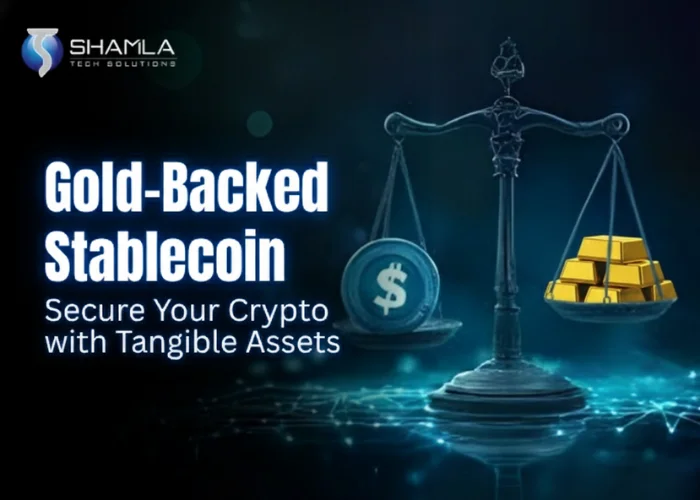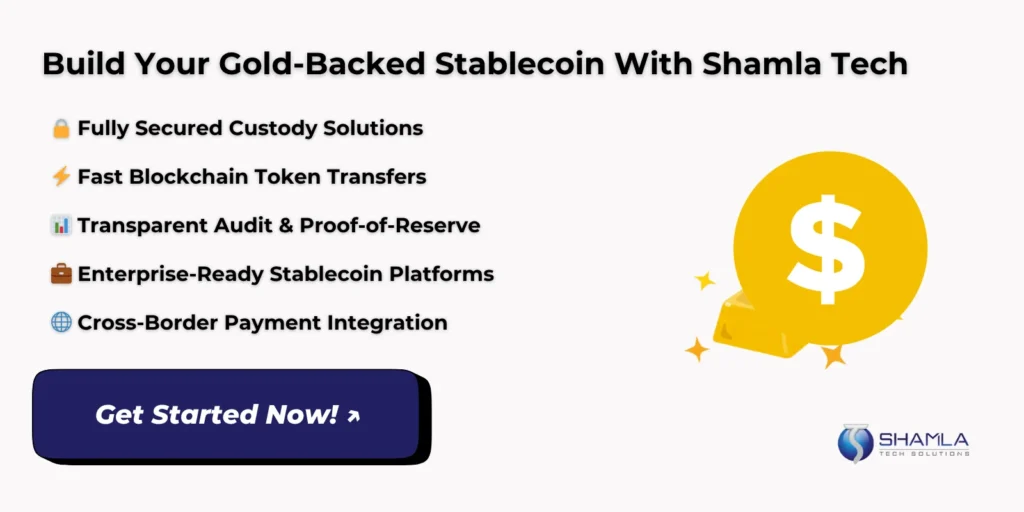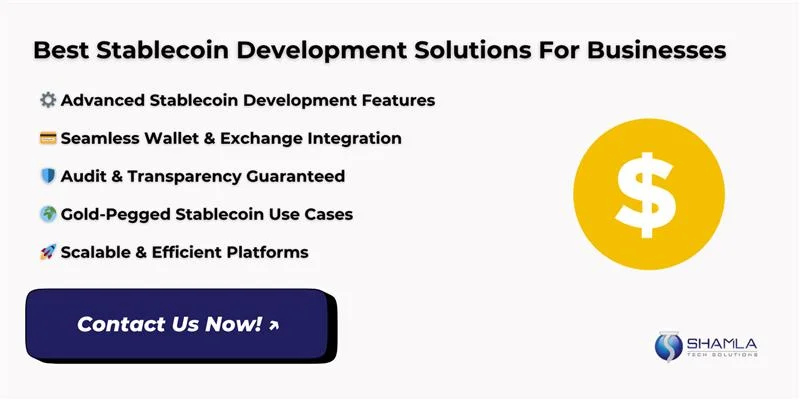Gold-backed stablecoin links each token to physical gold held in secure vaults, giving holders a clear asset base and liquidity. This gold-backed stablecoin design reduces price swings common in other coins and offers a simple store of value. Security rests on audited reserves, transparent proof-of-reserve reports, and regulated custodians.
Traders and savers use gold-backed crypto for low-volatility transfers, long-term saving, and as a hedge against inflation. Issuers use strict minting rules and on-chain tracking to match tokens to grams of gold. By combining blockchain ledgers with real gold, a crypto backed by gold can cut counterparty risk and improve trust.
What are Gold-Backed Stablecoins?
Gold-backed stablecoins are digital tokens that are linked to physical gold in vaults. These tokens give holders a claim on a set weight of metal and aim to hold steady value. Early stablecoins tied to fiat money showed why backing matters, so builders explored commodity models.
This entry shows a clear bridge between metal and ledger and defines the model in plain terms. Readers learn the basic role and why users choose it over loose tokens. The short history covers experiments, standards, and lessons learned. This paragraph notes the main types of stablecoins and shows where gold models fit.
How Gold Backing Works?
How gold backing works is simple: each token equals a fixed gram or fraction of gold in vaults and a gold-backed stablecoin links the token to that metal. Issuers keep metal in insured vaults and publish proof through audits or on-chain receipts. Minting and burning follow clear rules so token supply matches metal held.
Custody can be public or private, with third-party audits to verify reserves. This design lowers wild price swings and links value to a known asset. Practices vary, but the core is direct asset cover. Here we name one practical form as a gold-backed crypto used by traders.
Comparison With Other Stablecoins
Compare with other stablecoins by seeing what backs value and how risks differ; a gold-backed stablecoin sits in the commodity group. Fiat-backed coins hold bank cash; crypto-backed coins use other tokens as collateral. Commodity-backed projects tie value to a physical good like gold.
This makes a clear contrast and shows trade-offs in cost, speed, and trust. In real use, a gold backed crypto coin trades off liquidity versus steady value. Understanding these trade-offs helps builders and investors pick tools for each need. This paragraph repeats types of stablecoins to stress classification.
Technical Mechanics And Safeguards
Under the hood, systems use audits, custody controls, and public ledgers to track units so a gold-backed stablecoin keeps code and metal aligned. Smart contracts can record issuance and transfers, and oracles feed price feeds for gold. On-chain proof plus off-chain custody creates a link between code and metal.
Teams design reconciliation processes to fix mismatches and to let holders redeem tokens for metal. Clear rules and audit trails reduce fraud and stop hidden shortfalls. Developers must plan for vault insurance, legal titles, and clear redemption paths. Many call this model a digital gold currency in practice.
Market Role And Trust of Gold-Backed Stablecoins
Market role centers on stability, reserve use, and cross-border flows where banks lag and a gold-backed stablecoin can serve as a steady bridge. Investors use these tokens to move value with less swing than typical crypto. Traders use them for hedging, and platforms use them as base pairs in trades. Issuers set fees, custody rules, and redemption limits to manage supply.
Transparency and regulator alignment raise trust and adoption among large holders. A clear governance plan and visible proof of metal help a crypto backed by gold gain market share. Adoption grows when systems stay simple and reliable.
Benefits of Creating Gold-Backed Stablecoins
1. Price Stability And Hedging
A gold-backed stablecoin gives holders a clear value link to physical metal, so price swings are smaller than with many cryptocurrencies. Issuers store gold in insured vaults and publish audits so token supply matches metal held. That link helps savers protect buying power during market drops and lets traders hedge exposure using a concrete asset.
For firms, issuing such a token can lower funding costs versus unbacked tokens because creditors view them as safer. Strong mint and burn rules plus public proof of reserve keep the system honest and let anyone verify backing on chain and speed settlement across borders.
2. Faster Transfers And Liquidity
Token form lets gold move fast on blockchains. A token supports instant transfers, fractional ownership, and low minimums, so small investors can hold slices of an ounce. Exchanges list these tokens so traders can enter and exit positions without shipping metal.
As a gold backed digital currency, they can be used for cross-border payments with lower fees and faster settlement than bank wires. Wallets and custodial services onboard users quickly. Markets gain depth when custody providers and exchanges support trading pairs, improving price discovery and liquidity for both retail and professional traders and reducing operational friction for institutions globally today.
3. Custody Controls And Trust
Custody and proof matter for trust. A gold-backed stablecoin uses third-party vaults, insurance, and audit reports to show metal exists. That setup makes this token, an asset backed cryptocurrency, easier to trust than unbacked tokens. Smart contracts manage token records while custodians hold titles and handle redeem requests.
Regular proof-of-reserve and reconciliation help spot shortages quickly. When issuers use public attestations and licensed vaults, institutional buyers accept the token for treasury use. Clear legal ownership and simple redemption rules reduce counterparty risk and let markets price the token as a reliable store rather than a speculative asset.
4. Investment Products And Yield
Gold-pegged stablecoin tokens open access to new investment paths. Retail investors can buy small amounts without storing bars, while funds can add a regulated token to balance portfolios. Platforms build savings and yield products around the token, offering interest tied to gold lending or staking. For savers, low volatility makes planning easier.
For traders, these tokens provide hedging tools inside exchanges. Issuers set clear fees and redemption steps to keep costs predictable. Proper custody and compliance let banks and pension managers consider these options. Many see gold-backed crypto invest as a practical bridge between metal and digital finance and adoption.
5. Adoption, Regulation, And Market Fit
Adoption grows when markets see clear rules and public reserves. A gold-backed stablecoin wins trust when audits, insurance, and legal title documents are shared. A gold-pegged stablecoin that lists on major exchanges gains volume and pairing options fast. Redemption paths through partners make tokens useful for users and funds.
Institutional custody, tax clarity, and plain reporting attract big holders. Predictable fees and clear custody let more people treat tokens as savings. Services that promote gold-backed crypto invest products help retail access. Some critics push ideas like XRP backed by gold, but proof and law decide value and build steady markets.
Stablecoin Development and Regulation in 2025
1. Stablecoin Architecture And Development
A gold-backed stablecoin starts with solid architecture. A stablecoin development company defines token issuance, smart contract logic, and redemption mechanisms. Developers create on-chain mint/burn functions linked to vault-held gold, with automated reconciliation to track reserves. Key technical features include:
- Transparent ledger for token ownership
- Proof-of-reserve verification
- Secure private keys and multisig vault control
- API integration for exchanges and wallets
Proper design reduces errors and fraud. Stablecoin development solutions also include monitoring tools, alert systems, and compliance automation. Early design choices affect cost, reliability, and scalability, influencing the cost of stablecoin development and long-term market trust.
2. Custody And Reserve Management
Physical gold custody is critical for asset-backed stablecoins. Custodians hold insured vaults with strict auditing schedules. Developers implement:
- Regular proof-of-reserve reports
- Smart contract reconciliation for minting/burning
- Automated alerts for mismatches or shortages
- Clear redemption protocols for users
This ensures tokens always reflect the underlying gold. Regulatory alignment and public transparency build confidence. The system balances efficiency with security, ensuring the gold-backed stablecoin remains reliable and legally compliant.
3. Regulatory Landscape And Compliance
Stablecoin regulation 2025 emphasizes transparency, solvency, and consumer protection. Developers and issuers must:
- Maintain sufficient reserves audited by trusted third parties
- Implement anti-money-laundering (AML) and know-your-customer (KYC) procedures
- Comply with reporting and taxation rules
- Align token issuance with legal definitions of digital assets
Following stablecoin regulation 2025 ensures market acceptance and prevents legal penalties. Jurisdictions may differ, but strong compliance is essential for adoption by institutional investors and major exchanges.
4. Development Costs And Market Strategy
The cost of stablecoin development includes:
- Technical infrastructure setup
- Smart contract development and auditing
- Vault storage, insurance, and third-party audits
- Integration with exchanges and wallets
Stablecoin development solutions aim to reduce ongoing operational expenses through automation, monitoring, and reporting tools. Cost planning affects token economics, pricing, and investor confidence. Careful budgeting ensures asset-backed stablecoins remain sustainable, competitive, and attractive for both retail and institutional markets, enabling long-term adoption and liquidity growth.
Use Cases of Gold-Backed Stablecoins
1. Cross-Border Payments And Remittances
Gold-backed stablecoins simplify sending value across borders quickly and cheaply. Users can transfer tokens instead of traditional money, avoiding high fees and long bank processing times. A gold-backed stablecoin maintains value stability compared to volatile cryptocurrencies, giving senders and recipients confidence.
Companies and individuals use this system for payroll, supplier payments, or family remittances. Wallets, exchanges, and payment platforms support these tokens, improving accessibility. By using a gold-backed crypto or digital gold currency, users access liquidity anywhere, while the underlying gold maintains a store of value, combining convenience with trust and making cross-border payments a practical stablecoin use case.
2. Hedging Against Volatility
Investors hold gold-backed stablecoins to reduce exposure to volatile markets. Unlike typical cryptocurrencies, a gold-backed crypto coin tracks the value of physical gold, providing a stable base for portfolios. Traders can shift positions into these tokens during market swings, preserving capital.
Funds and institutional investors use asset-backed cryptocurrency tokens to balance risk and meet regulatory compliance. This hedging strategy allows market participants to plan and execute trades with predictable value. The use of a digital gold currency in hedging is a growing trend among top stablecoins in 2025, offering a trusted alternative to fiat or unbacked crypto assets.
3. Decentralized Finance And Lending
Gold-backed stablecoins are increasingly integrated into decentralized finance (DeFi) platforms. Users can lend, borrow, or stake tokens while maintaining stable value tied to physical gold. Platforms use smart contracts to automate interest, collateral, and liquidation processes. Investors earn yield while securing value, and borrowers access liquidity without converting to volatile coins.
Gold-backed stablecoins enhance DeFi ecosystem stability, allowing more predictable lending terms and reducing default risks. The tokens act as reliable collateral for synthetic assets or stablecoin swaps. This practical use highlights how a gold-backed stablecoin and other asset-backed cryptocurrency products expand the DeFi landscape.
4. Retail Payments And E-Commerce
Merchants and consumers increasingly accept gold-backed stablecoins for online and in-store purchases. A gold-backed stablecoin offers predictable pricing compared to volatile crypto, making it practical for daily transactions. Integration with payment gateways and wallets allows seamless checkout. Digital gold currency can be converted instantly to fiat or held as a store of value.
Some platforms offer loyalty programs or interest incentives when paying with gold-backed crypto. This practical stablecoin use case demonstrates adoption potential. By using these tokens, businesses can reduce transaction fees, protect against currency fluctuations, and provide customers with secure, gold-backed payment options.
5. Enterprise Solutions And Institutional Adoption
Gold-backed stablecoins are increasingly adopted by enterprises and financial institutions for treasury and liquidity management. Look for a stablecoin development company with features that helps design tokens with features like multi-tiered custody, regulatory compliance, audit trails, and integration with payment systems. These stablecoins act as commodity-backed stablecoins, providing predictable value tied to gold for corporate balance sheets.
Institutions use them for cross-border settlements, supplier payments, and internal fund transfers while reducing exposure to volatile cryptocurrencies. The stability and transparency of a gold-backed stablecoin, combined with robust development company features, make it a practical tool for enterprise finance and long-term institutional adoption strategies.
Conclusion
Gold-backed stablecoins provide a secure way to hold and transfer value, combining blockchain technology with tangible gold reserves. Their stability and transparency make them ideal for investors seeking predictable growth and risk management, while the practical stablecoin use cases ensure they remain a reliable tool for both retail and institutional users.
Shamla Tech is a top stablecoin development company offering businesses the best stablecoin development solutions. With expertise in creating compliant, efficient, and secure gold backed digital currency platforms, we empower enterprises to leverage blockchain technology while maintaining trust, transparency, and seamless integration into financial systems.
Contact us today to start building your secure, gold-backed stablecoin with Shamla Tech!





